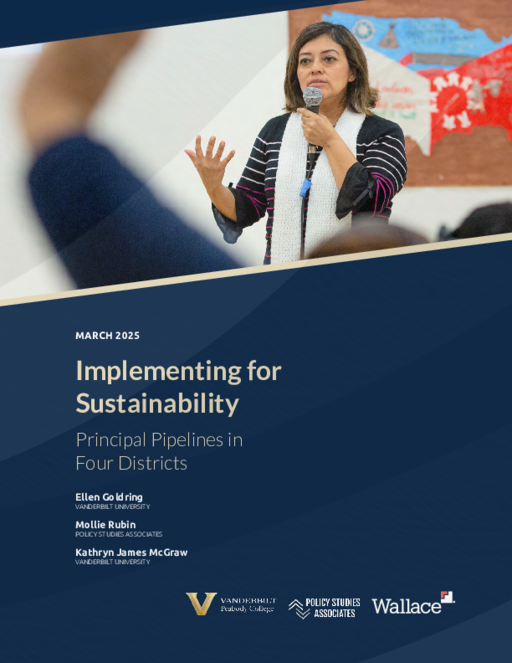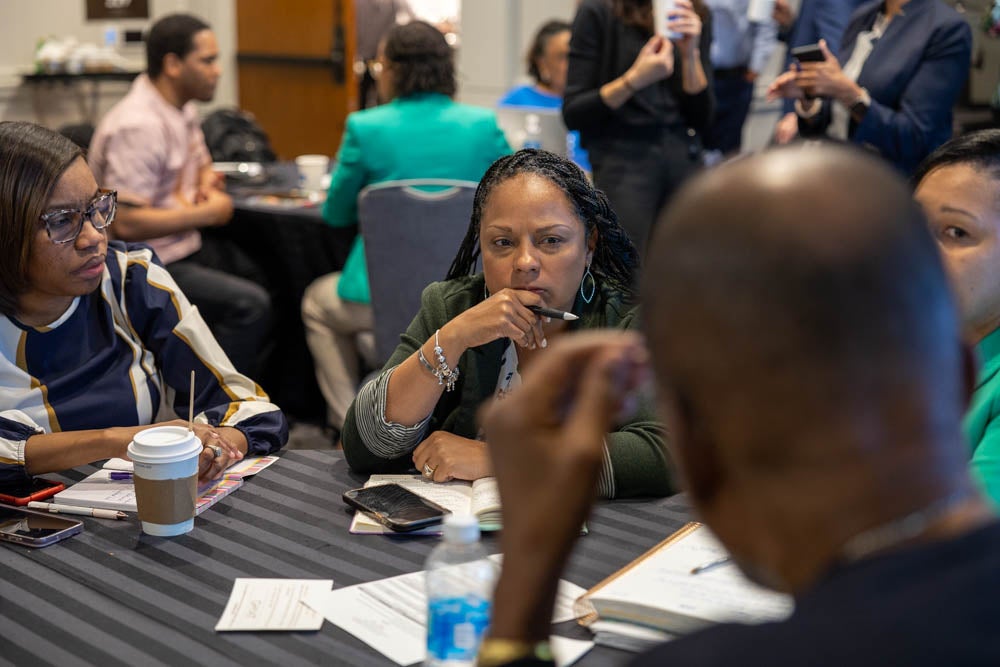Breadcrumb
- Wallace
- Reports
- Implementing For Sustainability ...
Implementing for Sustainability
Principal Pipelines in Four Districts

- Author(s)
- Ellen Goldring, Mollie Rubin, and Kathryn James McGraw
- Publisher(s)
- Vanderbilt University and Policy Studies Associates, Inc.
Summary
How we did this
The research team surveyed and interviewed a group of large- and medium-sized districts over a four-year period. These districts were all participants in a community of practice based on research findings from Wallace's Principal Pipeline Initiative. The Vanderbilt team tracked how these districts used the research results, including what changes they made in their principal pipelines. This report focuses on four of the districts that made significant and sustained changes.
How do districts create principal pipelines that last in the face of change and uncertainty? By thinking long-term from the start of planning.
This report from Vanderbilt Peabody College and Policy Studies Associates offers an "Implementing for Sustainability" framework. It also gives guidance for districts who want to incorporate sustainability as an early and ongoing part of developing principal pipelines. The framework builds on decades of prior research and was further developed through findings from the Principal Pipeline Learning Community (PPLC).
The PPLC was a network of 84 medium- and large-sized districts that Wallace helped bring together to plan, develop, and learn from the research on principal pipelines and one another. Wallace did not fund the districts. Those who participated sought to create effective and enduring systems for developing and supporting school leaders.
The framework in this report identifies four dimensions, or pillars, districts can work within when planning for long-lasting pipelines:
- Ensuring strategic alignment through vision and policy, such as making pipelines an explicit part of strategic plans and initiatives.
- Communicating clarity in Intent through social and organizational awareness, such as district leadership articulating a commitment to pipelines.
- Aligning institutional elements and supports through people and resources, such as dedicated funding streams and hiring additional personnel to support pipelines as needed.
- Maintaining priority (of pipelines) through culture, stakeholder engagement, and evaluation, such as communicating rationale of pipelines to board members and local leaders and setting clear goals and assessment movement toward those goal
Through interviews with technical assistance providers, the research team identified four districts who had taken proactive efforts to make sustainable evidence-based changes to their principal pipelines. They developed case studies to demonstrate how these districts were successful. The districts are: Newark Board of Education, Greenville County Schools, The School District of Philadelphia, and Cumberland County Schools.
The research team found that while every school district approached how it built its pipeline differently, there are common components across systems that found lasting success. These elements can help facilitate the pillars that make up the Implementing for Sustainability framework described above:
- A vocal champion who communicates the vision for leadership pipelines. High-level district leadership—such as the superintendent or assistant superintendent—set the tone that the pipeline was a central leadership path. It would help the district achieve its improvement goals, establishing a culture that values leaders and leader development.
- A pipeline leader who acts as the “hub.” One key leader coordinated across different departments. This leader had clear responsibility and authority along with access to resources to align the work across multiple departments.
- Central office coordination to foster collaboration around the pipeline. Districts broke down silos and created cross-departmental coordination to create coherence around the pipeline goals, programming, and desired outcomes. For example, districts provided resources to central office staff and schools for pipeline work, such as stipends and revised job descriptions.
- Alignment of pipeline evaluation metrics to broader district strategic goals and planning. Districts collected various forms of pipeline evaluation data and insights from focus groups of pipeline participants and their supervisors. This data focused on “return on investment,” which supported the continued allocation of resources for pipelines.

Sustainability as an ongoing process is embedded in pipeline planning, development, and implementation throughout the phases of the change process.
Key Takeaways
- The researchers developed a framework for sustainability that can be applied to a broad range of district initiatives including principal pipelines. It is comprised of four broad pillars:
- Ensuring strategic alignment
- Communicating clarity in intent
- Aligning institutional elements and supports
- Maintaining priority
- It is important to consider long-term sustainability in a change process as an ongoing part of planning and implementing principal pipelines.
- There are key common components to pipelines that last, which include a vocal champion of the work, a key leader across departments, coordination and collaboration across silos, and evaluative metrics that show how pipelines contribute to broader district goals.


